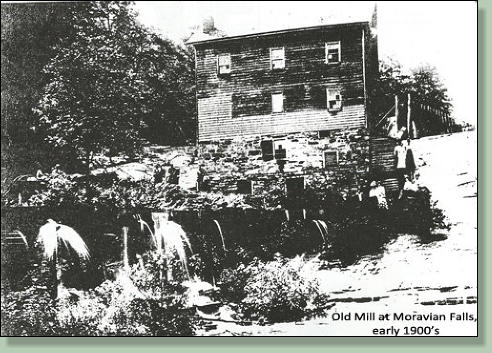

MORAVIAN FALLS FAMILY CAMPGROUND & CABIN RENTALS
AREA HISTORY
Come and Stay - It’s Special Here!
On January 15, 1994, Ken and Anita Wike found the
rare opportunity to purchase the Moravian Waterfall and
surrounding tracts of land at a public auction through
auctioneer Keith J. Pierce. They have worked to make
many upgrades while keeping the beauty of the natural
surroundings.
Wikipedia states:
Moravian Falls takes its name from a waterfall in the foothills of the Brushy
Mountains, which rise just 2 to 3 miles (4.8 km) to the south of the community.
Pores Knob, the highest peak in the Brushy Mountains, is located in Moravian
Falls. The area was originally settled by members of the Moravian Church in
1753, and Moravians owned the waterfall for many years. The waterfall is named
after the church.
Today the waterfall is a tourist attraction owned by Ken Wike who operates a
history rich family campground (Moravian Falls Family Campground). People
travel from many other parts of the country to enjoy the peaceful beauty of
nature.
The history of Moravian Falls goes back to the Granville grants of 1752 to the
Moravians. Col. William Pitt Waugh of Pennsylvania who had purchased a part of
the Moravian grant built the first mill at the Falls in 1803. That mill was the first bur
flour mill in Wilkes County. Waugh also built a corn mill, a linseed oil mill and a wool
carding machine, carrying on these industries until his death. After the death of Col.
Waugh, Richard Hix in 1849 bought the property and continued to operate the mills,
making linseed oil. He additionally erected a sash saw mill on Cub Creek.
Don R. Laws writes:
The village of Moravian Falls had its beginnings over 100 years ago. For many years
the place was know as the “Forks of the Road.” Later it took the name “Petersburg”
and about 1874 it took the name Moravian Falls.
The land surrounding the falls at Moravian falls was a part of two land grants made to
the Moravian Brethren who settled at Salem, North Carolina. These grants were
made in 1752 by Lord Granville, one of the eight Lords Proprietors appointed by
Charles II of England. This section was traversed by a creek named “Moravian” by
the surveyors sent out by the Moravian Brethren, hence the beautiful cascade on
Moravian Creek became known as Moravian Falls. In 1874 the little village, one half
mile from the Falls was officially named Moravian Falls at which time the post office
was established.
The territory now embraced in the Moravian Falls community was known up to the
breaking out of the Civil War as the Thirteenth United States Militia District. There
were 119 men in the Thirteenth Company subject to bear arms in the year of 1790,
which was during the administration of George Washington.
A goodly number of those eligible for military service lived in this community and the
names of several of these heads of families are familiar today. Among the list we find
Ben Hubbard, Thomas Lowe, Sam Lowe, Caleb Lowe, David Laws, William Laws,
Turner Hampton, Josh Greer, Jude Greer, Alexander Gilreath, John Gilreath and
William Gilreath, all familiar family names in this community today.
It was said of George Washington that he was first in war, first in peace and first in the
hearts of his countrymen. And it can be truthfully said that Moravian Falls was a first
in a good many things in Wilkes County.
The first bur flour mill in Wilkes was built at Moravian Falls. The first linseed oil mill,
and so far as it is know, the only one that ever operated in Wilkes was at Moravian
Falls. The first “chaff piler” threshing machine ran in Wilkes was at Moravian Falls.
The first “separator” thresher ran in Wilkes was at Moravian Falls.
The first steam engine and boiler to whistle in Wilkes was set up to drive a saw mill
and planer at Moravian Falls. The first and only iron smelter to produce iron from
native ore was extablished on Moravian Creek near Moravian Falls by Sam Brown.
This forge was in
operation during the
administration of
George Washington.
The first wagon scales
erected in the county
was at Moravian Falls.
The first tin shop in the
county was at Moravian
Falls. The first
compress in Wilkes for
bailing and preparing
medicinal herbs and
and roots for market
was run at Moravian
Falls.
The first turbine water
wheel to be run in this
county was at Moravian Falls. The first rural lighting plant to operate in Wilkes was at
Moravian Falls. The first circular saw to manufacture lumber was ran at Moravian
Falls. The first bicycle to to come to Wilkes was ridden at Moravian Falls.
The first typewriter known to be used in the county was at Moravian Falls in the year
1884. The first roller mill flour machine to run in Wilkes was set up at Moravian Falls.
The first tobacco factory to manufacture plug and twist was at Moravian Falls.
The first wireless telegraph station seen in Wilkes was built at Moravian Falls. The
first radio receiving set in Wilkes that would pick up distant programs was built at
Moravian Falls.
The first automobile purchased in the county came to Moravian Falls. The first
internal combustion engine to run in Wilkes was at Moravian Falls. The first and only
Rotary Web Perfecting printing press to be in in Wilkes was at Moravian Falls. The
first linotype to be run in Wilkes was at Moravian Falls. The first book binding done in
Wilkes was at Moravian Falls.
The first sterotype casting and printing in the county was at Moravian Falls. The only
school ever establish in Wilkes county that attained to county-wide, state-wide and
interstate reputation was Moravian Falls Academy founded at Moravian Falls in the
year 1876 by Professor George Green.
Perhaps no village of similar size in the whole country can lay claim to the starting of
as many publications as have been brought out in Moravian Falls in the last forty-odd
years.
Up to the days of the Civil War and extending back to the Revolution, there was a
stage coach road, leading from Wilkesboro which was known then as Mulbery Old
Fields on to Morganton. This road led by the “Brick House” in the “Forks of the Road”
practically along the line where Highway 18 now runs.
Another interesting feature of the early activities of the “Forks of the Road” was a race
track where horsemen from the country round about brought their animals and raced
for prizes.
~
The property changed ownership many times during the following years. In 1911, the
property was sold to J.T. Humphries and Smith Coachman of Clearwater, Florida and
an electric power plant was erected. This was the first electric power plant in the
county. In addition to furnishing electric power and lights to the communities of
Moravian Falls and Wilkesboro, the usual milling operations were carried on.
The old three story grist mill building was washed away in the 1916 flood. The mill
was later rebuilt and operated until the late 1930’s at which time business activities at
the Falls ceased.
For most of his life a man named Ralph Williams had a dream to own Moravian Falls
waterfall. His dream came true when in 1981 when a small development corporation
that had been turning the woods around the Falls into a commercial park declared
bankruptcy, and he stepped up and bought the Falls property of 38 acres at the
bankruptcy sale. Remarkably the land nor the community around it developed
significantly in a way that changed it for the worse.
Now owned and maintained by Ken and Anita Wike, the area serves still as a serene
area with a rich history and many enjoyable experiences.

© Copyright 2013-2023 Moravian Falls Family Campground & Rental Cabins - All Rights Reserved. Pam Clark Web Designs.com














